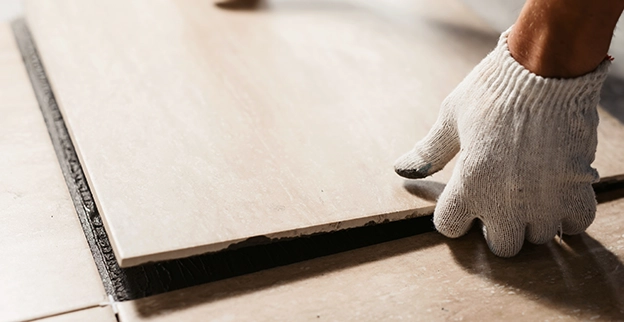There are many ways to use tile in a home or commercial building, from kitchen walls to bathroom floors. It’s a popular choice for areas prone to water exposure, but it also makes an excellent decorative element for almost any room. There are various types of tiles used in home construction and home improvement:
- Ceramic: These are popular for floors, walls, and countertops in kitchens and bathrooms.
- Porcelain: Durable and moisture-resistant, used in similar areas as ceramic tiles.
- Natural stone: Includes marble, granite, slate, etc., commonly used for floors, walls, and decorative purposes.
- Glass: Often used as accents or backsplashes in kitchens or bathrooms such as bathtubs or shower stalls.
- Mosaic: Small tiles assembled to create intricate patterns or designs used on walls, floors, and backsplashes.
- Vinyl: Typically used for flooring, known for being affordable and easy to install.
- Travertine: Used for floors, walls, and countertops, known for their unique natural patterns.
Homeowners can save themselves from costly fixes and installation with prompt services for a tile repair in Wichita, KS. When damage happens, reach out to your team to help you avoid bigger problems like unsightly cosmetic mishaps, potential injury, or future water damage to your subfloor or wall substrate. Tiles can experience many different types of damage from different factors or over-usage.
Common types of damage that we fix include:
- Stains: Tiles, especially porous ones like natural stone, can get stained from spills or chemical exposure.
- Wear and Tear: Continuous foot traffic or heavy usage can lead to surface wear and fading.
- Water Damage: Water infiltration can weaken the tile adhesive, leading to loose or displaced tiles.
- Efflorescence: A white, powdery substance can appear on the tile surface due to water migration and mineral deposits.
- Thermal Expansion: Extreme temperature changes can cause tiles to expand as well as contract, leading to cracking or delamination.
- Scratches: Hard or sharp objects can scratch the surface of some tile materials.
- Lippage: Uneven tile installation can result in raised edges or lippage between adjacent tiles.
Proper care, maintenance, and addressing issues can help extend the lifespan of tiles and reduce the risk of damage. Regular cleaning, sealing, and professional tile replacement or repairs are essential to keep tiles looking their best and functioning properly. Here are our technician’s strategies for some of the common problems needing tile repair in Wichita, KS:
- Damaged Grout Lines: Grout is necessary for any tile installation, but as a cement-based product, it’s really not as durable and long-lasting as the pieces themselves. That’s okay—when your excess grout lines start cracking or crumbling apart, or they’ve just become packed full of ground-in dirt that you can’t get rid of, we can use a carbide-tipped scoring tool to remove the grout and leave the pieces in place. We’ll then fill in the lines with fresh grout to make the entire surface look as good as new. If it’s a particularly moisture-prone area like a shower, we’ll use epoxy grout for a watertight seal.
- Chips and Hairline Cracks: Minor surface damage is unattractive, but it can also let in water or cause you to trip on an uneven surface. We can handle chip repair on porcelain or ceramic tile by filling it in with epoxy, sanding it smooth, and concealing the repair with a few coats of paint followed by a sealant.
- Loose Tiles: Occasionally, you may have a piece that is technically undamaged but has simply come loose from the mortar that was bonding it to the floor or wall underneath and needs tile repair in Wichita, KS. Our expert technicians not only take care of that easily by re-mortaring and re-grouting the loose piece to get it firmly back into place but will ensure that they provide lasting long-term solutions.
- Broken or Smashed Pieces: If one or two pieces have been smashed, the best broken tile repair strategy is to replace those individual pieces. However, it’s often difficult to find spare tiles if there weren’t any set aside when the original installation was done or if the unused ones no longer match the rest because they haven’t taken the same wear and tear damage over time. If a perfect match is unavailable, the entire surface will likely need tile replacement.
Our professional technicians repair various types of tiles commonly found in homes and commercial spaces. Whether it’s cracked ceramic tiles, chipped natural stone tiles, or loose vinyl tiles, we are skilled in addressing tile-related issues efficiently. Let’s explore the common household tiles and how our team will follow a meticulous repair process:
Ceramic and Porcelain:
- Inspect the damaged area to determine the extent of the issue.
- Remove any debris or loose pieces around the damage.
- Safely break the cracked pieces using a chisel and hammer.
- Clean and prepare the area for the new installation.
- Apply tile adhesive to the back of the replacement tile.
- Press the flat edges firmly into place, ensuring they align with the surrounding tiles.
- Allow the adhesive to set for the recommended time.
- Grout the repaired area, making sure to match the existing grout color.
- Clean any excess grout from the surfaces.
Natural Stone:
- Examine the chipped or damaged stones and assess the best approach.
- Use a diamond blade grinder to carefully smooth out minor chips or cracks.
- If necessary, remove and replace the damaged pieces of stone using a chisel and adhesive.
- Clean and prepare the area for the new stone pieces.
- Apply a stone-specific adhesive to the back of the replacement tile.
- Set the new one in place, ensuring it is level with the surrounding tiles.
- Allow adhesive to cure for the recommended time.
- Apply a stone sealer to protect the repaired tile and enhance its appearance.
Vinyl:
- Assess the loose or damaged vinyl and identify the cause.
- Lift the affected tile carefully using a putty knife or scraper.
- Clean the subfloor to ensure a smooth and even surface.
- Apply a fresh layer of vinyl adhesive to the subfloor.
- Press the vinyl back into place, making sure it adheres securely.
- Place a heavy object on the repaired section to ensure proper bonding.
- Allow the adhesive to set as per the manufacturer’s instructions.
- Clean any excess adhesive from the surfaces.
It’s important to note that these are general guidelines, and the specific repair or replacement process will vary depending on each unique circumstance and the extent of the repair job. Our professional expertise ensures a high-quality, professional repair for many different types of tiles. Reach out today and book your service appointment with one of our expert professionals. Your home deserves the best, and we can help you achieve it!






